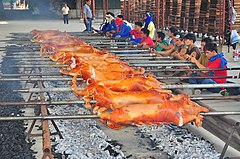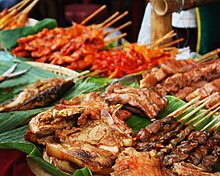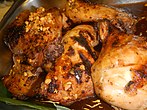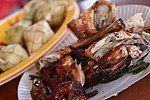이니호
Inihaw  | |
| 대체 이름 | 시누그바, 이나살, 이호이하, 스그바, 필리핀 바비큐, 피노이 BBQ |
|---|---|
| 원산지 | 필리핀 |
| 비슷한 요리 | 이나살, 레촌마녹, 사티, 사타이 |
시누그바 또는 이나살로도 알려진 이니호우는 필리핀에서 온 다양한 종류의 바비큐 요리이다.그것들은 보통 돼지고기나 닭고기로 만들어지며 대나무 꼬치에 얹어 먹거나 간장과 식초에 찍어 먹는 작은 정육면체 형태로 제공됩니다.이 용어는 또한 비슷한 방식으로 요리되고 제공되는 고기나 해산물 요리를 가리킬 수 있다.이니호는 보통 길거리 음식으로 팔리고 흰 쌀이나 코코넛 잎에 지은 쌀과 함께 먹는다.Inihaw는 때때로 필리핀 바비큐 또는 (비공식적으로) Pinoy [1][2][3]BBQ라고 불립니다.
묘사
Inihaw는 단순히 타갈로그어로 "구워졌다" 또는 "구워졌다"는 뜻의 총칭이다.세부아노에서는 [2]sinugba(동사 sugba, "구이하다"), 세부아노와 [4][5]힐리가이논에서는 inasal(동사 asal, "건열로 굽다", "꼬챙이에 꿰다")로 알려져 있다.그것은 영어 이름 "barbecue" (보통 "BBQ"로 줄임말)로도 간단히 언급될 수 있으며, 특히 [6][7][8]꼬치에 담겨 나오는 이니호(inihaw)에 대해서는 더욱 그렇다.이니호는 보통 돼지고기, 쇠고기 또는 해산물로 만들어집니다.저렴한 버전은 [1][9]내장으로도 만들 수 있습니다.
이니호에는 일반적으로 두 가지 종류가 있습니다.첫 번째는 간단히 고기나 해산물을 숯불에 직접 굽는 것입니다.겉은 검게 그을리고 속은 촉촉한 것이 특징이다.그것들은 보통 상에 내기 전에 깍둑썰기 되고, 간장과 식초를 섞어서 신선한 붉은 양파, 라부요 칠리, 칼라만시, 신선한 토마토, 간 검은 후추, 그리고/또는 설탕에 찍어 먹는다.두 번째 유형의 이니호는 고기나 해산물 요리를 꼬치에 꿰어 요리하거나 내놓는 것입니다.이것들은 통째로 구운 동물이나 정육면체 고기를 포함한다.두 종류 모두 요리하기 전에 양념할 수 있고 [3][10]요리하는 동안 양념할 수도 있다.
양념장은 보통 찍어 먹을 때 사용하는 소스와 비슷하다.꼬치에 꽂힌 이니호에서는 바나나 케첩과 아나토(아추에테) 오일을 사용하여 밝은 빨강이나 주황색으로 변하게 하는 달콤한 소스로 양념하거나 양념하기도 합니다.사티로 알려진 더 남부 버전들도 사테이와 [11][12]비슷하게 땅콩을 베이스로 한 소스와 함께 제공됩니다.
비사야어를 사용하는 지역에서는 돼지고기 이니호(sinihaw, 시누그바)와 키닐로(식초와 감귤 [13][14]주스에 생선회를 넣은 것)를 결합한 "sinuglaw"가 일반적인 조합이다.
바리에이션

이니호(inihaw)의 종류이지만, 일반적으로 구별되는 것으로 여겨지는 요리는 다음과 같습니다.[3]
- 레콘 - 보통 향신료와 레몬그라스로 [3]채워진 침구이 통돼지.
- 치킨 이나살 - 서부 비사야에서 온 레촌 마녹의 한 종류로, 칼라만시, 후추, 코코넛 식초, 아나토의 혼합물에 재운 닭고기를 양념장을 두른 후 뜨거운 석탄 위에 굽습니다.그것은 쌀, 칼라만시, 간장, 닭기름, 식초와 [15]함께 제공됩니다.
- 레촌마녹 - 닭고기를 마늘, 만엽, 양파, 후추, 간장, 파티스를 섞어 양념한 침구이 닭요리입니다.양념은 또한 머스코바도 또는 흑설탕으로 달여질 수 있다.탱글라드(레몽그라스)로 속을 채우고 숯불에 굽습니다.그것은 보통 간장, 칼라만시, 라부요 칠리의 토이만시 또는 실리만시 혼합물에 찍어 먹는다.그것은 흰 쌀밥이나 푸소와 짝을 이루어 반찬으로 아차라 피클과 함께 제공됩니다.그것은 필리핀에서 매우 인기 있는 음식으로 길가의 [16]레스토랑에서 쉽게 구할 수 있습니다.
- 사티 - 보통 민다나오의 꼬치에 구운 쇠고기나 닭고기를 얹어 먹는 것입니다.그것은 인도네시아와 말레이시아의 사테이와 관련이 있다.그것들은 보통 타무와 땅콩을 기반으로 한 [7][11]따뜻한 소스와 함께 먹습니다.
- 이자우 - 돼지 또는 닭의 내장으로 만든 매우 싼 꼬치의 일종이다.그것들은 고기 이니호와 [17]같은 방법으로 조리되어 먹는다.다른 종류의 내장 기반 이니호도 먹는데, 보통 다양한 일상 용품과 조잡하게 닮았기 때문에 익살스러운 이름을 붙인다.그것들은 "워커맨" (돼지 귀), "베타막스" (돼지 피), "헬멧" (닭 머리), 그리고 "아디다스" (닭 발)[1]를 포함합니다.
갤러리
「 」를 참조해 주세요.
레퍼런스
- ^ a b c Macatulad, JB. "4 Things to Know About Street Food in the Philippines". World Nomads. Retrieved 13 December 2020.
- ^ a b "Sinugba". Eat Your World. Retrieved 13 December 2020.
- ^ a b c d "10 Best Filipino Inihaw Recipes – Must Try!!". Panlasang Pinoy Recipes. Retrieved 13 December 2020.
- ^ "Inasal". Binisaya.com. Retrieved 12 February 2021.
- ^ Salcedo-Sillesa, Yolanda. "Chicken Inasal à la JT's : Bacolod-Style Grilled Chicken Recipe". Havenhill Cuisine. Retrieved 13 December 2020.
- ^ Ellen Brown (14 June 2016). "Smart Cooking: Philippine cuisine shaped by many influences". Providence Journal. Archived from the original on 8 February 2017. Retrieved 8 February 2017.
- ^ a b Jimenez, Gidget (2015). All About the Philippines: Stories, Songs, Crafts and Games for Kids. Tuttle Publishing. p. 59. ISBN 9781462917259. Archived from the original on 9 June 2020. Retrieved 5 September 2016.
- ^ Raichlen, Steven. "Filipino Satti". Barbeuce! Bible. Archived from the original on 2 January 2017. Retrieved 5 September 2016.
- ^ "Inihaw na Manok". Eat Your World. Retrieved 13 December 2020.
- ^ "The Happy Home Cook: Inihaw na Baboy (Grilled Pork)". Positively Filipino. Retrieved 13 December 2020.
- ^ a b "Unique Flavors of Western Mindanao: Satti". Archived from the original on 17 December 2014. Retrieved 15 January 2015.
- ^ Edgar Soon (2009). Pairing Wine with Asian Food. Monsoon Books. ISBN 9789814358941. Archived from the original on 9 June 2020. Retrieved 9 June 2020.
- ^ "Sinuglaw". Panlasang Pinoy. Retrieved 24 September 2019.
- ^ "Sinugba at Kinilaw". Lutong Bahay. Retrieved 13 December 2020.
- ^ "Manokan Country". Unofficial Guide, Philippines. Retrieved March 22, 2018.
- ^ Santos, Rachelle (17 September 2014). "Lechon Manok". Yummy.ph. Retrieved 20 January 2019.
- ^ Office of the Vice Chancellor for Research and Development (1999). "The Perils of Isaw and Fishballs". Research Folio. University of the Philippines Diliman. Retrieved 2009-10-20.
















